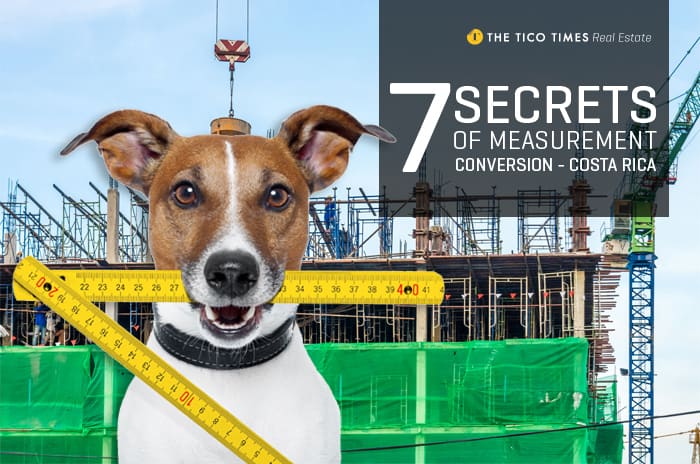In Costa Rica, we buy and sell land in square meters and in hectares, not in acres. And we measure houses in square meters, not in square feet. If you were educated in a different measurement system, it’ll take you a while to get used to it, but don’t give up your hopes of being able to adjust to a different measurement system as measurement conversion can eventually become old hat.
I have asked the design department of The Tico Times to come up with an easy-to-use and printable chart (see below) so you can save it on your smartphone for reference.
Even though many real estate agents in Costa Rica also use U.S. standard measurements in their real estate listings, I’d like to share seven secrets of Costa Rica real estate measurement conversion that you should know.
Secret #1: Land measurements – a hectare
We don’t measure anything in acres in Costa Rica but in square meters, and properties of larger size in hectares. A hectare is a metric unit of square measure, equal to 100 ares, or 10,000 square meters, equivalent to 2.471 acres.
Many real estate agents in Costa Rica will make it easier by calculating 2.5 acres to 1 hectare. Please refer to the measurement conversion chart in this article for exact conversion or use Google.
In the countryside of Costa Rica, you will find that lots of farmers still use the measurement of 1 manzana, which is 7,000 square meters or about 1¾ acre, even though it is not used as a formal measurement in the National Registry.
The word “manzana” also means apple, which has nothing to do with the measurement.
The Costa Rica legal system also uses the manzana measurement for agricultural parcels in its regulatory plans, but as 7,000-square-meter parcels. You will find many communities around Atenas and the coastal areas with agricultural parcels that access through an agricultural easement, where the zoning allows for only one house on each parcel.
You will find such communities mainly in mountain areas where only a small part of the land is buildable but allows for incredible views of either the ocean or the Central Valley.

Secret #2: Land measurements – a meter
Smaller properties in Costa Rica are usually measured in meters. A meter is 39.37 inches, or a little over a yard.
For easy conversion, most real estate agents in Costa Rica multiply a square meter (m2) by 11 to get the size of a house or building lot in square feet, and a linear meter multiplied by 3 gives the linear size in feet to measure, for example, the frontage of a property. Please refer to the measurement conversion chart in this article for exact conversion or use Google.
Secret #3: A quinta
A Spanish word you will probably see here and there advertised in Costa Rica real estate listings is the word quinta. A quinta is not a measurement, which is the reason you won’t find it on the measurement conversion chart. Quinta is the word for a small farm used as a weekend getaway, usually in the countryside. The size of a quinta usually ranges between 1,000 m2 (1/4 acre) and 1 acre.
Secret # 4: Construction measurements
Houses in Costa Rica are usually measured on the outside, so they include the thickness of the walls. That is probably also the reason that you will not see the sizes of the rooms advertised, as they do in other countries. Only real estate developers will publish a floor plan and it is always without the measurements.
Secret #5: Under roof
If you find a house for sale online, and the construction size is 2,500 square feet, it means that the house has 2,500 square feet “under roof.” That measurement includes the garage and terraces, as opposed to some countries where the advertised size of the house is air-conditioned space only.
Secret #6: Construction materials
In the matter of construction materials used in Costa Rica real estate, we have a weird situation. Costa Rica has little heavy industry, so many construction materials are imported. If you go to a hardware store, you will find a strange mix of measurements for a lot of articles.
Screws, bolts and nails are identified in pulgadas, the Spanish word for inches, as well as in millimeters. Wooden planks are ordered in varas, which is 3 feet or 0.8 meters. PVC pipes are sold per meter, but the diameter is measured in inches.
Secret #7: Condominiums
When you see condominiums or houses in gated communities advertised online, you should always question the advertised area. The National Registry shows the titled private area of each property. In some condominiums the parking is a private area, in which case it will have its own title, and in others the parking is a common area.
It is very common to see real estate agents just add up the apartment’s area, the two parking spots and the storage area, and this will make the condo look larger to an interested buyer than it really is. If you are shopping for a condo in Costa Rica, ask the agent what the living area of the condo is before you visit.
Ivo Henfling is a Dutch national, a resident of Costa Rica since 1980 and a Costa Rican real estate broker for over 20 years. He is the founder of GoDutch Realty, which covers several locations in the Central Valley, including Escazú, Santa Ana, Atenas, Cariari and Grecia. You can contact Ivo at (506) 2289-5125 / 8834-4515 or at ivo@godutchrealty.com.






